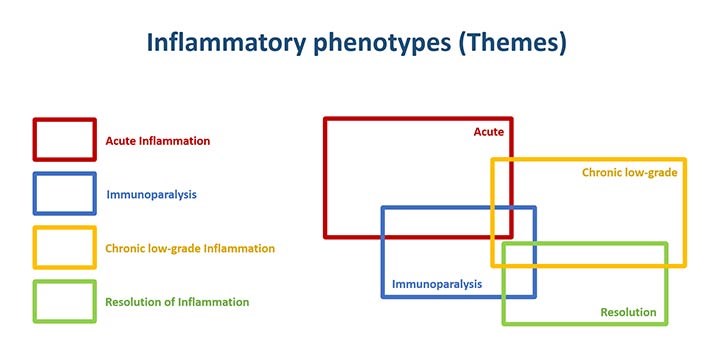A new concept of describing inflammation
Despite the fact that inflammation is highly involved in numerous diseases, the field of inflammation struggle to define the term, and are consistently tied to describe it from a disease-specific context. X-HiDE aims to establish a novel view of inflammation that goes beyond specific diseases. Inflammation will be described as inflammatory phenotypes with both unique and overlapping features. The phenotypes are based on fundamental clinical manifestations of inflammation, and are as follows:
Acute Inflammation
Acute inflammation is characterized by a high magnitude of effector molecules produced over relatively short time that leads to increased levels of tissue and immune involvement. While acute inflammation is fundamentally protective, if uncontrolled, this rapid and excessive production of inflammatory mediators might lead to organ failure during infections, trauma, pancreatitis, burns, and cardiac surgery.
Low-grade, Chronic Inflammation
Recent decades of research, concerning common diseases tightly connected to a modern lifestyle, have revealed another side of the inflammatory response. The metabolic syndrome, type II diabetes, and cardiovascular disease are prime examples of conditions that are characterized by a complex and long-term interaction between lifestyle and genetics, leading to chronic, low-grade inflammation. As opposed to acute inflammation, with its characteristic cardinal signs, this chronic low-grade inflammatory response is characterized by low magnitude of inflammatory mediators during longer periods of time.
Immunoparalysis
Inflammatory responses are a large set of proinflammatory mechanisms and mediators, that include processes designed to limit inflammation and promote return to tissue homeostasis, referred to as anti-inflammatory or pro-resolving. In contrast to earlier beliefs that the detrimental effects of systemic inflammatory conditions were solely caused by an excessive acute inflammation, mortality and morbidity are today also recognized to be linked to excessive anti-inflammatory mechanisms resulting in immunoparalysis.
Resolution
Resolution of inflammation is an innate aspect of the other inflammatory phenotypes - but where the magnitude of acute inflammatory responses does not become excessive, or where low-grade inflammation is not allowed to persist over time, and where reversal of early immunoparalytic events instead leads to restoration of immune function and return to homeostasis. Such a healthy inflammatory response is the key to why most individuals, despite constant inflammatory pressure and presence of various risk factors, do not develop clinical disease.

A new model of inflammation as inflammatoy phenotypes
